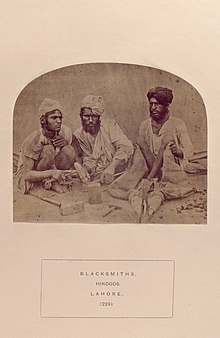 | |
| Regions with significant populations | |
|---|---|
| • India • Nepal |
Lohar is considered to be a caste among . [1][2] They form traditionally artisanal castes.[3] Writers of the Raj period often used the term Lohar as a synonym for blacksmith, although there are other traditional smiting communities, such as the Ramgarhia and Sikligar, and numerous non-traditional communities, including the Kayastha, Rajput and Brahmin.[4]
- ^ Bhattachan included the Lohar among the Madhesi Dalit in his report on minorities in Nepal, listing some 82,000. Bhattachan, Krishna B. (2008). Indigenous Peoples & Minorities of Nepal. Nepal Federation of Indigenous Nationalities (NEFIN). p. 49. Archived from the original on 12 March 2013.
- ^ In Annex I, Bhattarai lists the Lohar as iron-workers under the Madhesi as 0.36% of the Nepalese population. Bhattarai, Hari Prasad (2004). "Cultural Diversity and Pluralism in Nepal: Emerging Issues and the Search for a New Paradigm" (PDF). Contributions to Nepalese Studies. 31 (2): 293–340, page 339. Archived (PDF) from the original on 15 May 2011.
- ^ Perez, Rosa Maria (2004). Kings and Untouchables: A Study of the Caste System in Western India. Orient Blackswan. p. 80. ISBN 978-8-18028-014-6.
- ^ Judge, Paramjit S.; Bal, Gurpreet (1996). Strategies of social change in India. M.D. Publications. p. 54. ISBN 978-81-7533-006-1. Retrieved 21 March 2012.
© MMXXIII Rich X Search. We shall prevail. All rights reserved. Rich X Search
